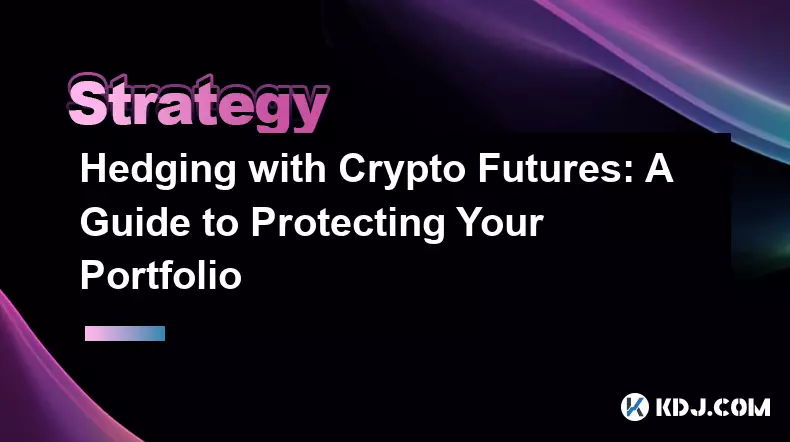-
 bitcoin
bitcoin $94896.319736 USD
-0.39% -
 ethereum
ethereum $3130.546781 USD
-0.60% -
 tether
tether $0.999368 USD
-0.10% -
 xrp
xrp $2.232415 USD
1.03% -
 bnb
bnb $931.833054 USD
0.53% -
 solana
solana $138.573946 USD
-0.08% -
 usd-coin
usd-coin $0.999844 USD
-0.08% -
 tron
tron $0.292320 USD
-0.61% -
 dogecoin
dogecoin $0.159558 USD
-1.12% -
 cardano
cardano $0.489320 USD
-1.89% -
 hyperliquid
hyperliquid $38.634250 USD
0.58% -
 zcash
zcash $700.952791 USD
3.30% -
 bitcoin-cash
bitcoin-cash $486.511218 USD
-3.00% -
 chainlink
chainlink $13.831174 USD
-1.13% -
 unus-sed-leo
unus-sed-leo $9.209054 USD
0.47%
Hedging with Crypto Futures: A Guide to Protecting Your Portfolio
Crypto futures help investors hedge against volatility by locking in prices, protecting portfolios without selling assets.
Sep 07, 2025 at 07:18 am

Hedging with Crypto Futures: A Guide to Protecting Your Portfolio
Cryptocurrency markets are known for their extreme volatility. Sudden price swings can erase gains in a matter of hours. For investors holding large positions in digital assets, this unpredictability poses a significant risk. One effective method to mitigate this exposure is through the use of crypto futures contracts. These financial instruments allow traders to lock in prices and protect their portfolios against adverse market movements.
Understanding Crypto Futures Contracts
1. Crypto futures are agreements to buy or sell a specific cryptocurrency at a predetermined price on a set future date. These contracts are traded on regulated exchanges such as CME, Binance Futures, and Bybit.
- Unlike spot trading, where ownership of the asset changes hands immediately, futures trading involves a commitment to transact at a later time.
- Futures can be settled in cash or through physical delivery, depending on the exchange and contract type.
- Each contract has a standardized size, such as 1 BTC per contract, making it easier to calculate exposure.
- The leverage offered in futures markets amplifies both potential gains and losses, requiring careful risk management.
How Hedging Works in Practice
1. Suppose an investor holds 10 BTC purchased at $30,000 each and is concerned about a potential market downturn. To hedge, they can short 10 BTC futures contracts at the current market price of $35,000.
- If the price drops to $25,000, the value of the physical BTC holdings decreases by $100,000. However, the short futures position gains $100,000 in profit, offsetting the loss.
- Conversely, if the price rises, the gains on the spot holdings are partially reduced by losses on the futures position, but the overall portfolio remains more stable.
- This strategy is especially useful for long-term holders who do not want to sell their assets but seek protection during uncertain periods.
- Institutional investors frequently use this approach to manage risk while maintaining exposure to the underlying asset.
Key Risks and Considerations
1. Improper timing or sizing of a hedge can lead to unnecessary losses, especially if the market moves in the expected direction but not by the anticipated magnitude.
- Funding rates in perpetual futures contracts can accumulate over time, eating into profits if the hedge is held for an extended period.
- Leverage increases the sensitivity of positions, and liquidation can occur if price moves sharply against the hedge.
- Market liquidity varies across exchanges and contract types, which can impact the ability to enter or exit positions at desired prices.
- Regulatory changes in different jurisdictions may affect the availability or legality of futures trading, adding another layer of complexity.
Frequently Asked Questions
What is the difference between hedging with futures and simply selling your crypto?Hedging allows you to maintain ownership of your assets while protecting against downside risk. Selling removes exposure entirely, which may trigger tax events and eliminate future upside potential.
Can retail investors effectively use futures for hedging?Yes, many crypto exchanges offer user-friendly futures platforms with educational resources. However, understanding margin requirements and contract specifications is essential before engaging in hedging strategies.
Do all cryptocurrencies have futures markets?No, only major cryptocurrencies like Bitcoin, Ethereum, Solana, and a few others have active and liquid futures markets. Smaller altcoins often lack sufficient trading volume for effective hedging.
What happens when a futures contract expires?Upon expiration, the contract is settled based on the agreed terms. In cash-settled contracts, the difference between the entry price and settlement price is paid in stablecoins or fiat. In physically delivered contracts, the actual cryptocurrency changes hands.
Disclaimer:info@kdj.com
The information provided is not trading advice. kdj.com does not assume any responsibility for any investments made based on the information provided in this article. Cryptocurrencies are highly volatile and it is highly recommended that you invest with caution after thorough research!
If you believe that the content used on this website infringes your copyright, please contact us immediately (info@kdj.com) and we will delete it promptly.
- Stablecoins Take Center Stage: Revolutionizing Cross-Border Trading in Africa
- 2025-11-17 21:40:02
- Navigating the Crypto Market: $HUGS Token vs. Selling Fear
- 2025-11-17 22:10:02
- Mutuum Finance: The Next Cardano in the Crypto Universe?
- 2025-11-17 22:25:01
- CMC20 on BNB Chain: DeFi's Answer to the S&P 500, Ya Know?
- 2025-11-17 21:10:02
- DeFi Strategies Evolved: Shared Capital Takes Center Stage
- 2025-11-17 22:40:01
- Solana Price Prediction: Will SOL Break $150 or Plunge?
- 2025-11-17 22:05:01
Related knowledge

A Guide to Trading Altcoin Seasons: How to Maximize Your Gains.
Nov 16,2025 at 11:00pm
Understanding Altcoin Seasons1. An altcoin season refers to a market phase where alternative cryptocurrencies outperform Bitcoin in terms of price gro...

The Beginner's Guide to Decentralized Exchanges (DEX): Trading with Control.
Nov 16,2025 at 05:20pm
The Beginner's Guide to Decentralized Exchanges (DEX): Trading with Control Decentralized exchanges, commonly known as DEXs, are transforming the way ...

A Guide to Crypto Tax Strategies: How to Minimize Your Tax Bill.
Nov 17,2025 at 10:39pm
Crypto Tax Basics Every Investor Should Know1. Cryptocurrency is treated as property by tax authorities in most jurisdictions, meaning every transacti...

Lump-Sum vs. DCA in Crypto: A Guide to Choosing the Right Strategy.
Nov 16,2025 at 06:40am
Lump-Sum Investing in Cryptocurrencies1. Lump-sum investing involves allocating a large amount of capital into cryptocurrency assets all at once. This...

How to Trade Crypto Breakouts: A Strategy for Capturing Big Moves.
Nov 16,2025 at 03:59pm
Understanding Crypto Breakouts1. A breakout in the cryptocurrency market occurs when the price of an asset moves beyond a defined support or resistanc...

The Complete Guide to Liquidity Mining: Earning Rewards in DeFi.
Nov 14,2025 at 12:40am
Understanding Decentralized Exchanges in the Crypto Ecosystem1. Decentralized exchanges (DEXs) operate without a central authority, allowing users to ...

A Guide to Trading Altcoin Seasons: How to Maximize Your Gains.
Nov 16,2025 at 11:00pm
Understanding Altcoin Seasons1. An altcoin season refers to a market phase where alternative cryptocurrencies outperform Bitcoin in terms of price gro...

The Beginner's Guide to Decentralized Exchanges (DEX): Trading with Control.
Nov 16,2025 at 05:20pm
The Beginner's Guide to Decentralized Exchanges (DEX): Trading with Control Decentralized exchanges, commonly known as DEXs, are transforming the way ...

A Guide to Crypto Tax Strategies: How to Minimize Your Tax Bill.
Nov 17,2025 at 10:39pm
Crypto Tax Basics Every Investor Should Know1. Cryptocurrency is treated as property by tax authorities in most jurisdictions, meaning every transacti...

Lump-Sum vs. DCA in Crypto: A Guide to Choosing the Right Strategy.
Nov 16,2025 at 06:40am
Lump-Sum Investing in Cryptocurrencies1. Lump-sum investing involves allocating a large amount of capital into cryptocurrency assets all at once. This...

How to Trade Crypto Breakouts: A Strategy for Capturing Big Moves.
Nov 16,2025 at 03:59pm
Understanding Crypto Breakouts1. A breakout in the cryptocurrency market occurs when the price of an asset moves beyond a defined support or resistanc...

The Complete Guide to Liquidity Mining: Earning Rewards in DeFi.
Nov 14,2025 at 12:40am
Understanding Decentralized Exchanges in the Crypto Ecosystem1. Decentralized exchanges (DEXs) operate without a central authority, allowing users to ...
See all articles










































































